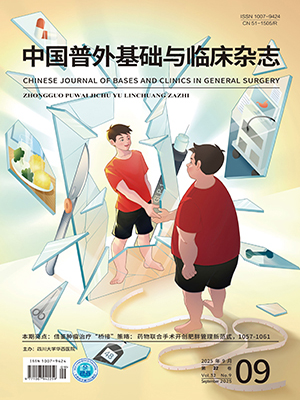| 1. |
He Y, Liang D, Li D, et al. Incidence and mortality of laryngeal cancer in China, 2015. Chin J Cancer Res, 2020, 32(1): 10-17.
|
| 2. |
Silva-Velazco J, Dietz DW, Stocchi L, et al. Considering value in rectal cancer surgery: an analysis of costs and outcomes based on the open, laparoscopic, and robotic approach for proctectomy. Ann Surg, 2017, 265(5): 960-968.
|
| 3. |
Keller DS, Delaney CP, Hashemi L, et al. A national evaluation of clinical and economic outcomes in open versus laparoscopic colorectal surgery. Surg Endosc, 2016, 30(10): 4220-4228.
|
| 4. |
Simillis C, Lal N, Thoukididou SN, et al. Open versus laparoscopic versus robotic versus transanal mesorectal excision for rectal cancer: a systematic review and network meta-analysis. Ann Surg, 2019, 270(1): 59-68.
|
| 5. |
Ning Y, Wang L, Giovannucci EL. A quantitative analysis of body mass index and colorectal cancer: findings from 56 observational studies. Obes Rev, 2010, 11(1): 19-30.
|
| 6. |
Bayraktar O, Ayta? E, ?zben V, et al. Does robot overcome obesity-related limitations of minimally invasive rectal surgery for cancer? Surg Laparosc Endosc Percutan Tech, 2018, 28(1): e8-e11.
|
| 7. |
韓彩文, 田宏偉, 杜斌斌, 等. 機器人輔助技術在普外科的應用現狀和前景展望. 中國普外基礎與臨床雜志, 2020, 27(12): 1598-1603.
|
| 8. |
Son IT, Kim DW, Choe EK, et al. Oncologic evaluation of obesity as a factor in patients with rectal cancer undergoing laparoscopic surgery: a propensity-matched analysis using body mass index. Ann Surg Treat Res, 2019, 96(2): 86-94.
|
| 9. |
中國醫師協會結直腸腫瘤專業委員會機器人手術專業委員會, 中國研究型醫院學會機器人與腹腔鏡外科專業委員會. 機器人結直腸癌手術中國專家共識(2020版). 中國實用外科雜志, 2021, 41(1): 12-19.
|
| 10. |
中華醫學會外科學分會腹腔鏡與內鏡外科學組, 中華醫學會外科學分會結直腸外科學組, 中國醫師協會外科醫師分會結直腸外科醫師委員會, 等. 腹腔鏡結直腸癌根治術操作指南(2018版). 中華消化外科雜志, 2018, 17(9): 877-885.
|
| 11. |
Bunyavejchevin S. Overactive bladder symptom scores responsiveness before and after anticholinergic treatment in women with overactive bladder: the pilot study. J Obstet Gynaecol Res, 2017, 43(7): 1189-1193.
|
| 12. |
Neijenhuijs KI, Holtmaat K, Aaronson NK, et al. The international index of erectile function (IIEF)—a systematic review of measurement properties. J Sex Med, 2019, 16(7): 1078-1091.
|
| 13. |
Neijenhuijs KI, Hooghiemstra N, Holtmaat K, et al. The female sexual function index (FSFI)—a systematic review of measurement properties. J Sex Med, 2019, 16(5): 640-660.
|
| 14. |
NCD Risk Factor Collaboration (NCD-RisC). Trends in adult body-mass index in 200 countries from 1975 to 2014: a pooled analysis of 1 698 population-based measurement studies with 19. 2 million participants. Lancet, 2016, 387(10026): 1377-1396.
|
| 15. |
Shiomi A, Kinugasa Y, Yamaguchi T, et al. Robot-assisted versus laparoscopic surgery for lower rectal cancer: the impact of visceral obesity on surgical outcomes. Int J Colorectal Dis, 2016, 31(10): 1701-1710.
|
| 16. |
Bjoern MX, Nielsen S, Perdawood SK. Quality of life after surgery for rectal cancer: a comparison of functional outcomes after transanal and laparoscopic approaches. J Gastrointest Surg, 2019, 23(8): 1623-1630.
|
| 17. |
Peltrini R, Luglio G, Cassese G, et al. Oncological outcomes and quality of life after rectal cancer surgery. Open Med (Wars), 2019, 14: 653-662.
|
| 18. |
Eid Y, Bouvier V, Menahem B, et al. Digestive and genitourinary sequelae in rectal cancer survivors and their impact on health-related quality of life: outcome of a high-resolution population-based study. Surgery, 2019, 166(3): 327-335.
|
| 19. |
Fang J, Zheng Z, Wei H. Reconsideration of the anterior surgical plane of total mesorectal excision for rectal cancer. Dis Colon Rectum, 2019, 62(5): 639-641.
|
| 20. |
Kim HS, Kang JH, Yang SY, et al. Long-term voiding and sexual function in male patients after robotic total mesorectal excision with autonomic nerve preservation for rectal cancer: a cross-sectional study. Surg Laparosc Endosc Percutan Tech, 2020, 30(2): 137-143.
|
| 21. |
Aselmann H, Kersebaum JN, Bernsmeier A, et al. Robotic-assisted total mesorectal excision (TME) for rectal cancer results in a significantly higher quality of TME specimen compared to the laparoscopic approach—report of a single-center experience. Int J Colorectal Dis, 2018, 33(11): 1575-1581.
|
| 22. |
Huang CW, Tsai HL, Yeh YS, et al. Robotic-assisted total mesorectal excision with the single-docking technique for patients with rectal cancer. BMC Surg, 2017, 17(1): 126. doi: 10.1186/s12893-017-0315-x.
|
| 23. |
Pigazzi A, Ellenhorn JD, Ballantyne GH, et al. Robotic-assisted laparoscopic low anterior resection with total mesorectal excision for rectal cancer. Surg Endosc, 2006, 20(10): 1521-1525.
|
| 24. |
唐波, 曾冬竹, 張超, 等. 達芬奇機器人手術系統輔助直腸癌根治術456例報道. 中國普外基礎與臨床雜志, 2016, 23(12): 1419-1423.
|
| 25. |
Lee SH, Kim DH, Lim SW. Robotic versus laparoscopic intersphincteric resection for low rectal cancer: a systematic review and meta-analysis. Int J Colorectal Dis, 2018, 33(12): 1741-1753.
|
| 26. |
Tang X, Wang Z, Wu X, et al. Robotic versus laparoscopic surgery for rectal cancer in male urogenital function preservation, a meta-analysis. World J Surg Oncol, 2018, 16(1): 196. doi: 10.1186/s12957-018-1499-y.
|
| 27. |
Yamaoka Y, Kagawa H, Shiomi A, et al. Robotic-assisted surgery may be a useful approach to protect urinary function in the modern era of diverse surgical approaches for rectal cancer. Surg Endosc, 2021, 35(3): 1317-1323.
|
| 28. |
Panteleimonitis S, Pickering O, Abbas H, et al. Robotic rectal cancer surgery in obese patients may lead to better short-term outcomes when compared to laparoscopy: a comparative propensity scored match study. Int J Colorectal Dis, 2018, 33(8): 1079-1086.
|
| 29. |
Wang G, Wang Z, Jiang Z, et al. Male urinary and sexual function after robotic pelvic autonomic nerve-preserving surgery for rectal cancer. Int J Med Robot, 2017, 13(1): e1725. doi: 10.1002/rcs.1725.
|




